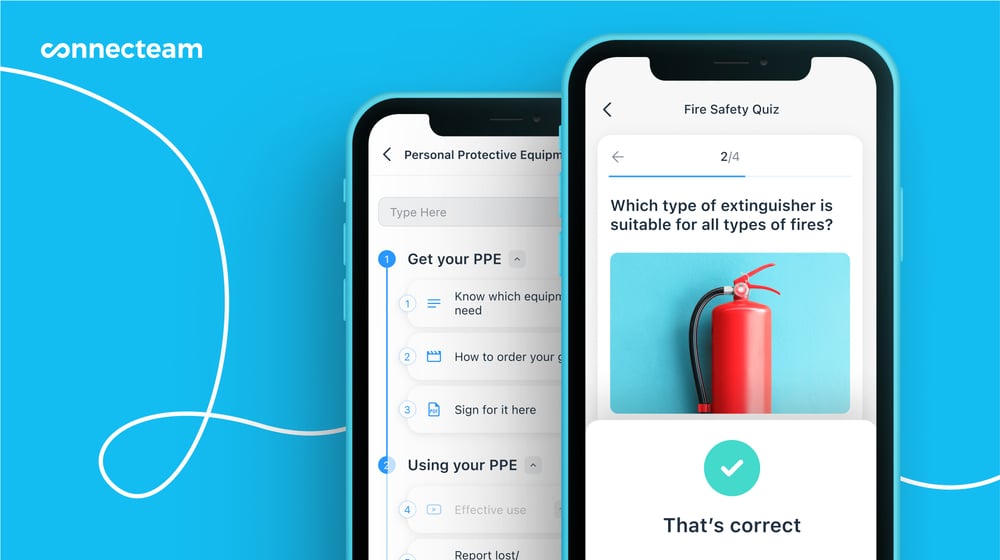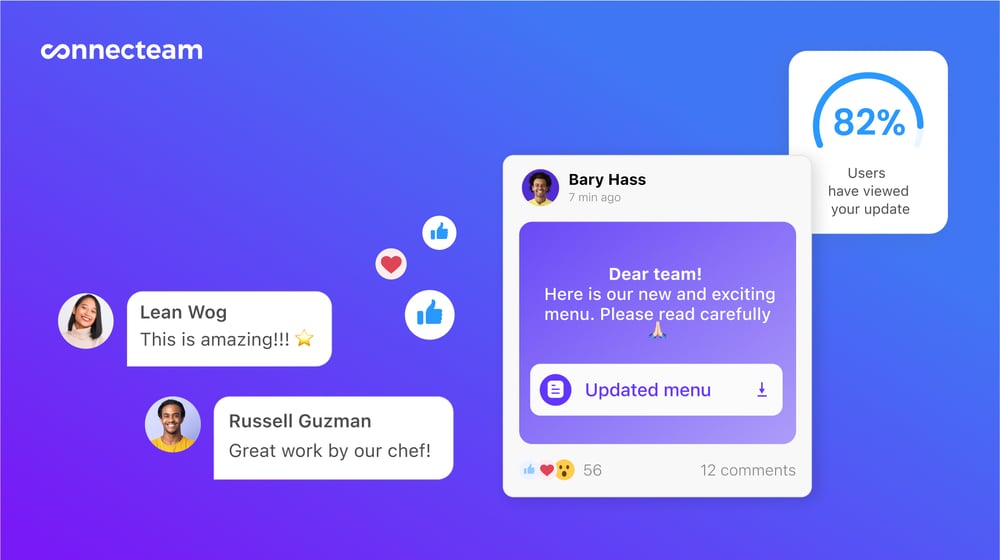Skilled and motivated employees are the backbone of any successful company. To ensure your employees have the right knowledge to succeed, you need to create a training program that sets them up for success.
This article delves into the nuances of training. We offer insights and strategies to ensure that your workforce is not just informed, but also empowered to drive your business forward.
Why is Employee Training Important
A comprehensive training program directly influences a company’s productivity, quality of service, and overall growth. Additionally, 82% of employees consider on-the-job training the most effective way to learn, so it’s definitely with the investment.
Training helps create a warm and inviting welcome for new employees. It allows them to easily integrate so they feel a part of the team. And by investing in skills training, employees are equipped with the knowledge they need to do their jobs.
Another important reason you should take employee training seriously is because it fosters a culture of continuous learning and improvement. It also boosts employee morale, job satisfaction, and loyalty, as employees recognize the business’s commitment to their personal and professional development.
Overall, training is a strategic tool that, when effectively implemented, results in a more efficient, innovative, and competitive organization.
7 Tips to Optimize Employee Training
Here are 8 important strategies to ensure you have a comprehensive and effective employee training program.
Identify training needs
First and foremost, creating a training plan means you need to identify what your employees actually need to know to do their jobs well.
You can do this by evaluating your business goals, speaking to the hiring manager and business owner, and reviewing industry standards. You may also want to conduct employee surveys of current team members to better understand what they think is essential for new hires to learn.
It’s also important to understand new employees’ knowledge levels before they join the company. You can identify new employee training needs through practical assessments and job try-outs.
Don’t waste time teaching new hires what they already know–make sure to create customized training materials for reach role that hones in on the skills they need to learn. In fact, 91% of respondents in a recent survey said they’d want a training plan that’s personalized and relevant.
Don’t forget about employee onboarding
A Harvard report concluded that companies with formal onboarding programs see 50% better retention and 62% greater productivity among new hires.
So, why is onboarding so important? It’s your new employees’ official welcome to the team. Onboarding sets the tone for their entire experience working for your company and helps new staff settle into their roles. The process should also begin before their official start date.
The onboarding process may consist of:
- A welcome letter
- Distribution of the employee handbook
- New hire gifts
- Setting up important technologies, like your company’s employee management app
- Arranging the official first day of work
- Putting them in touch with an onboarding buddy (87% of companies who place employees with a mentor or buddy found it to be effective)
- Introductions to the team
- Company orientation
- Introduction to the company culture
Provide a roadmap and easy access to training materials
The effective training process for new employees should be transparent and easy to follow. Not only is it important to have customized training materials, but new team members should have a clear understanding of the training process from the very beginning. This includes what information will be covered and how long the process will take.
This is particularly important for remote and non-desk employees who may be completing a large part of their training from the field.

The best way to create a plan and clear training roadmap is to upload all of your training materials to an employee training app so new staff can view them all at one time. They’ll have access to all the materials from their phones, no matter where they are, and can view and review everything at their own pace.
They’ll be able to easily follow the order of training and see what’s next on the agenda throughout the process.
Utilize microlearning and online training
Research suggests that within 24 hours, learners forget 70% of new information. That’s why microlearning can be such an effective training strategy: this training method involves presenting small, bite-sized pieces of information in shorter increments.
When employees complete online microlearning from their phones, it actually results in four times higher engagement rates and 50% better knowledge retention than traditional e-learning tools!
As opposed to long, in-person training sessions, implementing microlearning techniques into online training allows employees to remain more engaged in what they’re learning and retain information better.
Mobile apps also allow employers and employees to monitor progress and adjust their training as necessary. Training from smartphones also keeps employee engagement levels high because it utilizes different forms of media to deliver training, such as quizzes and videos.
Have a good communication system in place
During the training process, employees are bound to have questions. It’s vital to have a communication system in place for easy, two-way communication between employees and managers.
New team members should be able to reach other team members, their onboarding buddies, and their managers with the click of a button. As a manager, you should also be able to check in with your newest team members and make sure they’re understanding all the new information being presented to them.
💡 Pro Tip:
Connecteam’s team communication app comes with all the chat features you need to stay in touch with your staff in real time. Securely chat one-on-one or create group chats with multiple staff at once with the Smart Groups feature.

Monitor training progress
Monitoring employee training progress is crucial because it ensures that employees are meeting their learning objectives. It also allows you to measure if training is working. The average cost of training a new employee is $1,071, so it’s important that your training program is effective to avoid wasting time and resources.
By tracking progress, managers can identify areas of concern early on, allowing for timely interventions and adjustments to the training program.
You should also make sure to hold performance reviews during the first few months of employment. This gives you the chance to check in with employees as they adjust to their new roles and get a sense of how they’re feeling.
🧠 Did You Know?
With an employee training app like Connecteam, you can monitor training progress through the employee timeline feature and easy-to-use communication features. You can also set the app to alert you when employees complete specific training modules, tasks, and quizzes.
Prioritize ongoing training and professional development
Training employees effectively involves more than just new employee training; it involves continued learning and professional development, too.
Regularly offering professional development courses is important for both new and existing employees for a few reasons:
- Employees can adapt to change: Ongoing training ensures that employees’ technical knowledge stays up to date with industry standards and trends.
- Enhances employee performance: Regular training refines employee skill sets, addresses performance gaps, and introduces new techniques, leading to improved efficiency, productivity, and quality of work.
- Boosts employee retention: Offering continuous development opportunities can increase job satisfaction and loyalty. Employees are more likely to stay with an organization that invests in their growth and career progression.
- Cultivates leadership: Ongoing training prepares employees for leadership roles, ensuring a steady pipeline of qualified individuals ready to take on higher responsibilities.
- Helps your company maintain a competitive advantage: Companies that prioritize continuous learning are better positioned to innovate and stay ahead of competitors. A well-trained workforce can respond more effectively to market challenges and opportunities.
🧠 Did You Know?
70% of employees would be somewhat likely to leave their current jobs to work for a company that prioritizes employee development and learning.
💡 Pro Tip:
From onboarding to ongoing development, keeping track of employee training can be complex. Our guide to employee training tracking software offers solutions to help you manage certifications, track learning milestones, and maintain a motivated, skilled workforce.
Employee Training is Essential for Business Success
Training new employees is a foundational investment in the future of your business. A well-structured onboarding and training program ensures that new employees integrate into the company culture, understand their roles, and contribute to the team from the get-to.
By using a combination of microlearning, in-person training, online learning, and continuous feedback, you can create a business environment where new hires feel valued and motivated to succeed.
As your industry continues to evolve, so should our approach to training. You should adjust your training program as needed to create a workforce that’s not only skilled but also engaged and aligned with the company’s vision and values.




